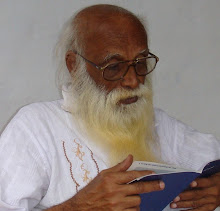Next only to Indra, Agni, the God of Fire, has the largest number of hymns in Rg Veda dedicated to him. He is central to the fire sacrifice, the greatest observance of the religion of those times. The myths indicate that he was recognized in two forms. The first was “given” fire, ignited naturally when thunderstorms struck the trees, and carefully preserved by privileged sages. The second was made fire, which the sages generated by friction of two twigs of hardwood. Both forms were duly deified.
Later myths furnish conflicting accounts of the origin of Agni, and his “parentage”. According to one version, he is one of the six “mental children”, i.e., created by a wilful intention of the mind, by Brahma the Creator himself. Agni is usually associated with the sage Angiras, who is the inventor of many Vedic rituals and verses. Agni is described as the mouth of the gods, through which burnt offerings of humans reach the divine. He is counted among the five great elements, viz., Ether, Fire, Wind, Water, and Earth.
According to a story in Maha Bharatam, Agni was cursed to be insatiable. Bhrigu, one of the earliest of the great sages, had set Agni to guard his pregnant wife Puloma. One day, Puloma’s earlier boy friend, Puloman, found out from Agni that Bhrigu had left on tour. Puloman took the form of a boar and kidmapped her. Frightened and crying out, she gave premature birth to a beautiful son. Puloman the boar fled. Bhrigu on return learnt that Agni had revealed the secret of his absence, and cursed him to be insatiable in his hunger. Agni sulked and offerings were no longer conveyed to the gods from the sacrifices. Brahma the Creator had to interfere, and bless Agni with the power to purify all that he touched.
Swaaha, daughter of Daksha Prajapati, had long coveted Agni as her mate.
Another story connects him with Siva, Parvathy, and their son Subrahmanya. Siva’s seed was so hot that it threatened to burn everything it touched. Agni took it up and deposited in the
Agni still continues to be the holy fire in which all burnt offerings are deposited, for conveyance to the respective gods. But there are now very few temples dedicated exclusively to him. He is represented by an icon as the Dikpalaka (Guardian) of the southeast, in the charts of the eight guardians of the directions (Ashtadikpalaka).

No comments:
Post a Comment